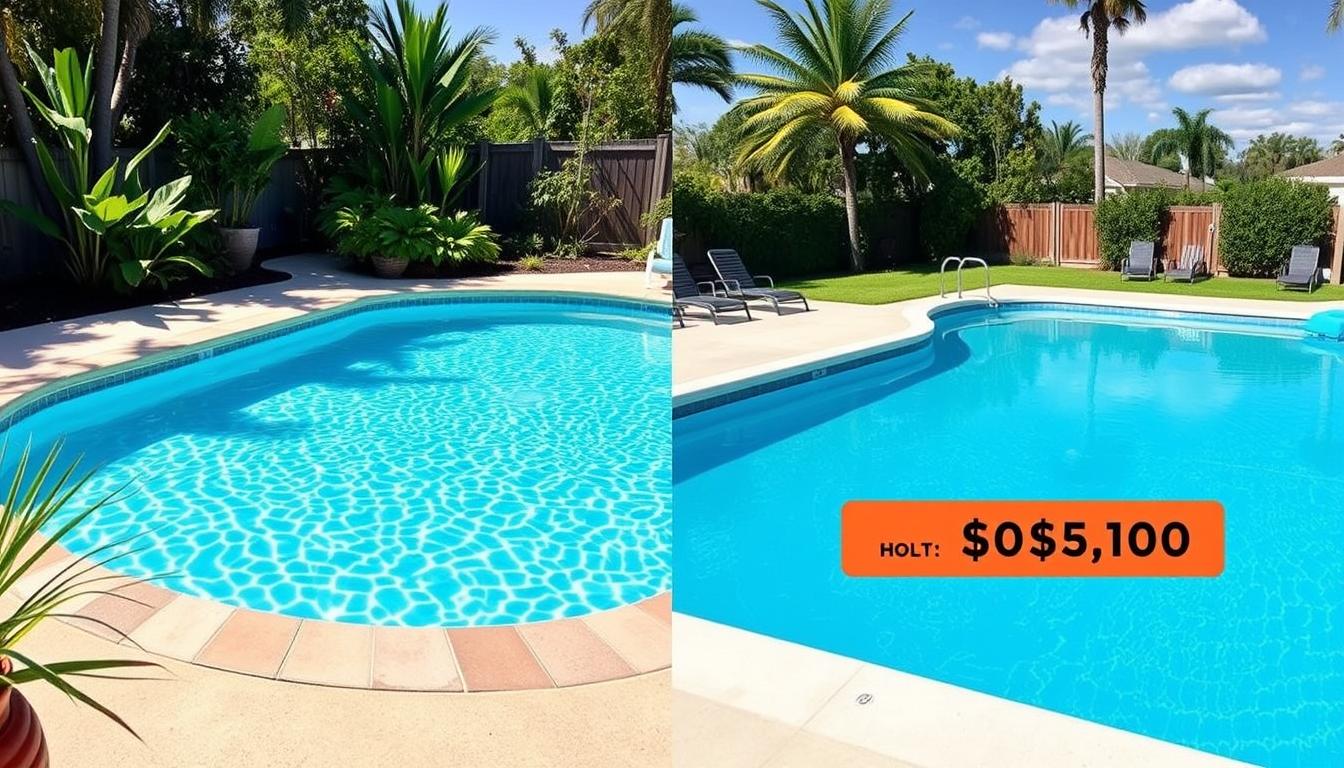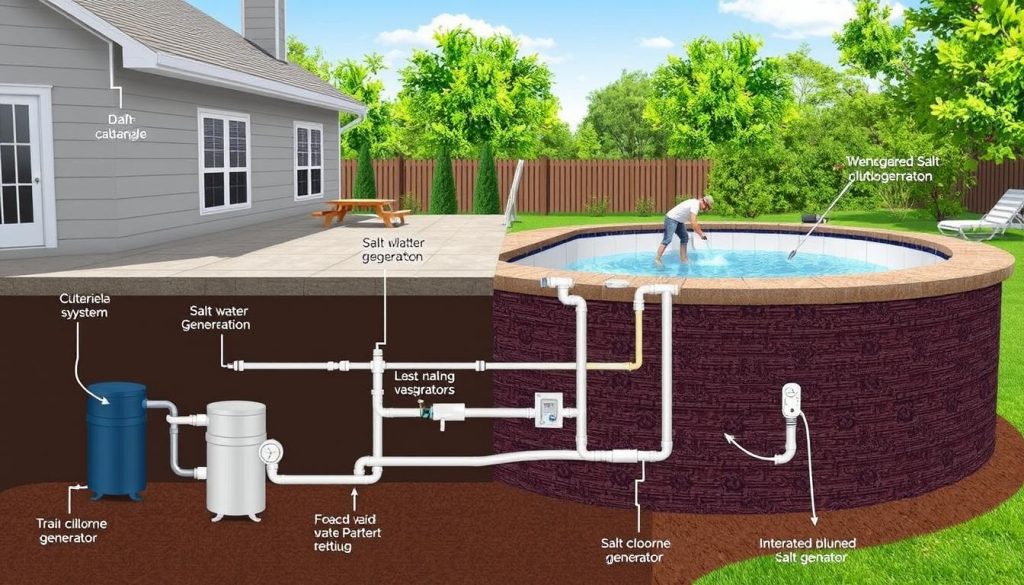
Saltwater pool installation costs about $45,000, while chlorine pools average $35,000. This price gap is crucial for homeowners planning a new pool. The salt water pool vs chlorine cost debate involves both initial and long-term maintenance costs.
Saltwater pools are popular for lower upkeep costs and skin-friendly features. However, their setup is pricier due to special equipment like salt chlorine generators. These can add $3,000 to $15,000 to the initial cost.
Chlorine pools have lower upfront costs but higher long-term expenses. Yearly chlorine pool chemical costs range from $400 to $800. In contrast, salt water pool chemical costs are only $100 to $400 annually.
Weekly upkeep for chlorine pools is about four times more expensive and time-consuming. This difference in maintenance can significantly impact overall costs over time.
Upfront Costs: Salt Water Pools Have Higher Initial Expenses
Salt water pools have higher initial costs than traditional chlorine pools. The specialized equipment, like the salt chlorine generator, adds to these expenses. Let’s examine the costs for both types of pools.

Salt Water Pool Installation Costs
Installing a salt water pool costs $3,000 to $15,000 more than a chlorine pool. The salt chlorine generator alone can cost $1,700 to $2,500 upfront.
Pool salt ranges from $10 to $25 per 40-pound bag. Some brands sell bags for up to $40.
Chlorine Pool Installation Costs
Chlorine pools have lower startup costs. They use standard methods of applying chlorine, such as tablets, liquid, or powder.
The main expenses include the pool itself and the basic filtration system. Long-term maintenance costs for chlorine pools can add up over time.
Converting a Chlorine Pool to Salt Water
Converting a chlorine pool to salt water can cost $1,500 to $10,000. The price depends on pool size and conversion complexity.
Vinyl liner and concrete pools may face higher maintenance costs when converted. This is due to potential corrosion and damage from salt exposure.
| Expense | Salt Water Pool | Chlorine Pool |
|---|---|---|
| Installation Costs | $3,000 to $15,000 more than chlorine pools | Lower startup costs |
| Salt Chlorine Generator | $1,700 to $2,500 upfront | Not required |
| Pool Salt | $10 to $25 per 40-pound bag | Not required |
| Conversion from Chlorine to Salt Water | $1,500 to $10,000 | Not applicable |
Salt Water Pool vs Chlorine Cost: Long-Term Maintenance and Repairs
Salt water and chlorine pools have different long-term costs. Maintenance, repairs, and effects on swimwear are key factors to consider. Salt water pools often save money over time, despite higher initial costs.
Salt Water Pool Maintenance Costs
Salt water pools are cheaper to maintain than chlorine pools. Owners typically spend about $85 yearly on salt and chemicals. Salt costs $3 to $6 per 5-pound bag.
Salt cells in the generator need replacement every 3-5 years. This can cost between $200 and $800.
Chlorine Pool Maintenance Costs
Chlorine pools have higher upkeep costs than salt water pools. Annual chemical expenses range from $300 to $800. This is 3 to 8 times more than salt water pool maintenance.
| Pool Type | Annual Maintenance Costs |
|---|---|
| Salt Water Pool | $85 |
| Chlorine Pool | $300 – $800 |
Durability and Repair Costs
Chlorine pools are simpler and often cheaper to repair. They have fewer complex parts that can break down. Salt water pools may need pricier fixes if the generator fails.
Salt water can damage some pool parts. These include heaters, lights, fixtures, liners, and masonry. Special salt-resistant equipment may be needed, increasing costs.
Impact on Swimwear and Fabrics
Salt water pools are kinder to swimwear and fabrics. Chlorine pools can fade and wear out swimsuits faster. Salt water causes less damage if the pH is balanced correctly.
While salt water pools may have higher upfront costs, their lower maintenance expenses and reduced impact on swimwear and fabrics can make them a more cost-effective choice in the long run.
Conclusion
The long-term cost is crucial when choosing between salt water and chlorine pools. Salt water pools have higher upfront costs but are often more cost-effective over time. Lower maintenance and fewer chemicals can lead to significant savings.
Chlorine pools have lower initial costs but need more frequent upkeep. They require regular water testing, chlorine level adjustments, and manual chemical additions. This can be time-consuming and expensive.
Your budget, maintenance preferences, and desired swimming experience will guide your choice. Salt water pools offer a more natural environment with smoother water and no chlorine smell. However, they may corrode metal parts and wear down pool plaster faster.
Consider the long-term costs and benefits of each option. This will help you make the best choice for your needs and preferences.







